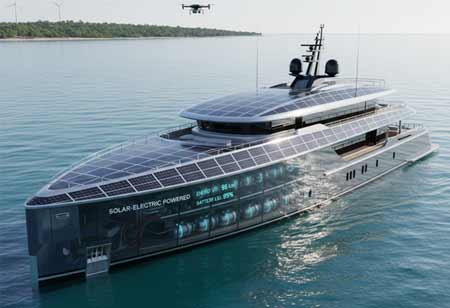CLOSE
Specials
I agree We use cookies on this website to enhance your user experience. By clicking any link on this page you are giving your consent for us to set cookies. More info
Be first to read the latest tech news, Industry Leader's Insights, and CIO interviews of medium and large enterprises exclusively from Energy Tech Review
Thank you for Subscribing
Solar-Powered Yachts as the Pinnacle of Conscious Design
The rise of solar-powered yachts redefines luxury, emphasising sustainability and innovative design, aligning modern owners with environmental consciousness while providing opulent, emission-free experiences at sea.

By
Energy Tech Review | Monday, November 17, 2025
Stay ahead of the industry with exclusive feature stories on the top companies, expert insights and the latest news delivered straight to your inbox. Subscribe today.
For decades, the pinnacle of marine luxury was defined by engine power, displacement, and opulent interiors. It was a world measured in horsepower and knots. Today, a paradigm shift is underway, driven by a new, more discerning generation of owners. The ultimate luxury is no longer just about consumption; it is about consciousness. Sustainability has evolved from an afterthought into the very essence of high-end design, and the solar-powered yacht is its new, silent, and brilliant icon.
This transformation is redefining the very meaning of opulence at sea. The new luxury is experiential. It is the ability to run a full suite of five-star amenities—from air conditioning and stabilisation to advanced entertainment systems—powered entirely by the sun. It is the deep-seated satisfaction of enjoying the planet's most beautiful and fragile ecosystems while leaving no trace, no emissions, and no disturbance.
European high-net-worth individuals, in particular, are championing this move. They are seeking assets that align with a broader legacy of environmental stewardship. This isn't about compromise; it's about enhancement. The appeal is twofold: the intellectual satisfaction of commanding a vessel powered by cutting-edge, clean technology, and the visceral, sensory pleasure of silent, emission-free cruising. This shift is turning the yacht from a symbol of power into a platform for harmony, a private retreat that is truly in sync with the natural world it explores.
The New Architecture of Light and Power
This sustainable ethos is fundamentally reshaping yacht design. The solar-powered vessel is not simply a traditional yacht with panels added on; it is an entirely new typology of marine architecture. Designers and naval architects are no longer fighting to hide the power source. Instead, they are celebrating it, integrating photovoltaic technology directly into the vessel's form with aesthetic grace.
Solar cells are no longer bulky, obtrusive additions but are incorporated into the very skin of the yacht. Expansive flybridges, hardtops, and even the hull itself are being designed as "solar-smart" surfaces. These panels are becoming a design language in their own right, with advanced cells that are flexible, durable, and aesthetically versatile, capturing immense amounts of energy without marring the yacht's sleek profile. To maximise the energy harvested from the sun, these yachts must be exceptionally efficient. This has accelerated the use of advanced, lightweight materials. Carbon fibre, infused composites, and lightweight alloys are becoming the standard, reducing displacement and minimising drag. Hulls are becoming slipperier and more hydrodynamic, often taking the form of highly efficient multihulls, which offer the added benefit of vast, stable living platforms.
Inside, the luxury of sustainability continues. Interior design studios are sourcing rare and beautiful materials that are also renewable, recycled, or reclaimed. We see interiors crafted from certified woods, natural fibres, eco-conscious leathers, and textiles made from recycled ocean plastics, all without sacrificing an ounce of comfort or tactile luxury. Because electric propulsion systems are often more compact than their traditional counterparts, designers are also finding new interior volume to create more open, light-filled spaces that further connect the owner to the outside environment.
The Technological Heart of Silent Cruising
Beneath the polished surfaces of these vessels lies a sophisticated ecosystem of green technology. The technological heart of the modern solar yacht is a triad of advanced photovoltaics, high-capacity energy storage, and intelligent power management.
The solar arrays seen on today's new builds are vastly more efficient than those of even a few years ago. Marine-grade cells are being developed to be highly resistant to the harsh saltwater environment while maximising energy capture, even in diffused light or partial shade. This constant, silent generation of power is the key that unlocks autonomy. This energy is channelled into substantial energy storage systems, often liquid-cooled and designed for high-cycle life, capable of holding enough power to run all "hotel loads" (lighting, navigation, stabilisation, galleys, and entertainment) through the night. They also power the vessel's electric propulsion motors.
This electric propulsion is vibration-free and provides instant torque for manoeuvring. While many of the largest vessels operate as solar-hybrids—using their vast solar arrays to drastically reduce or eliminate generator use at anchor and supplement propulsion underway—a growing number of boats are achieving actual solar-electric propulsion, capable of cruising for significant distances on sunlight alone.
Tying it all together are highly sophisticated, "smart" energy management systems. These digital brains constantly monitor and optimise energy flow. They automatically balance power generation from the sun, the state of the battery banks, and the demands of the propulsion and hotel systems. This ensures maximum efficiency, routing surplus energy to storage and guaranteeing that not a single watt of solar power is wasted. This seamless, intelligent operation makes the entire system intuitive and effortless for the crew and owner.
Europe as the Epicentre of the Green Wave
The continent combines a deep-rooted heritage of maritime craftsmanship with a powerful regulatory and cultural push towards decarbonization. The historic shipyards of Northern Europe and the Mediterranean are applying centuries of shipbuilding expertise to this new challenge. They possess the engineering prowess and artisanal skill required to build these complex, lightweight, and technologically dense vessels. They are not just building boats; they are crafting finely tuned instruments for clean-energy cruising.
The desire to protect Europe's most cherished cruising grounds—from the azure coves of the Greek Isles to the fragile ecosystems of the Baltic Sea—provides a powerful incentive. Stringent environmental regulations in these protected areas are driving demand for vessels with a minimal ecological footprint.
The solar-powered yacht is the definitive statement of modern luxury. It represents a pivot point for the entire marine industry, proving that high-end design, technological innovation, and profound environmental responsibility can coalesce into a single, beautiful, and silent form. This is the new standard, and it is quietly, powerfully, and elegantly shaping the future of yachting.

Copyright © 2025 Energy Tech Review. All rights reserved






